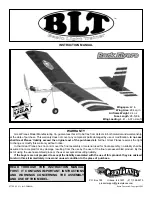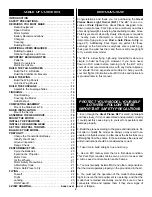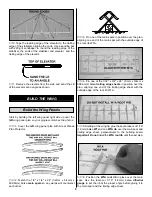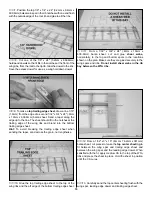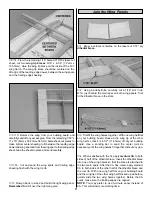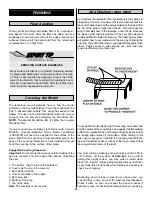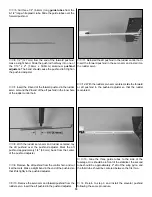
4
In addition to the equipment listed in the
“Decisions You
Must Make”
section, following is the “short list” of the most
important building supplies required to build the BLT.
We
recommend
Great Planes Pro
™ CA and Epoxy glue.
❏
1/2 oz. Thin Pro CA (GPMR6001)
❏
1/2 oz. Medium Pro CA+ (GPMR6007)
❏
Hobby knife (HCAR0105)
❏
#11 blades (HCAR0211)
Building Supplies
ADDITIONAL ITEMS REQUIRED
Note:
The period required to charge the batteries in the
examples above is for discharged batteries. If the battery
you are going to charge is not discharged, connect it to
the motor on your model. Run the motor until the
propeller is turning slowly, thus discharging the battery.
Covering
There are several types of covering that may be used on
the BLT, and a few that are not recommended. Use a
covering suitable for lightweight models. Top Flite
®
EconoKote
®
and Coverite
™
Micafilm are suitable for the
BLT. EconoKote is similar to MonoKote (used on most
regular-size sport models), except EconoKote is lighter
and does not shrink as tightly, thus making it suitable for
lightweight structures such as that of the BLT. EconoKote
also has an adhesive on the back which is activated by
the heat of a model airplane covering iron.
Coverite Micafilm is another covering suitable for
lightweight structures. Micafilm has fibers imbedded in
the film and is exceptionally strong, yet remains
lightweight because it has no adhesive on the back.
Therefore, you must apply an adhesive to the structure
before application. Use Coverite Balsarite (COVR2500)
for Micafilm. Do not use Balsarite “film formula” to apply
Micafilm.
Transparent MonoKote film is also suitable for covering
the BLT, because it is lighter and does not shrink as tightly
as opaque MonoKote film (and is the covering that is on
the model featured on the box label). Opaque MonoKote
film is
not
recommended for the BLT because it is too
heavy and shrinks too tightly for the structure to withstand
the pressure.
Building board
You will need a flat board to lay over your workbench that
you can stick pins into. The back of a 2’ x 4’ ceiling tile or a
section cut from a sheet of Celotex insulation board is ideal.
Panasonic 7-cell 1200 mAh NiMh
(GPMP0300) for
advanced pilots requiring the longest duration (not
recommended for beginners due to the fact that it is
heavier than the 550 mAh batteries).
Note:
If flying the
BLT at altitudes of 3,000 feet above sea level or higher,
beginners should select the 7-cell 550 mAh battery pack,
as the 6-cell pack may not provide adequate power.
ATTENTION:
The product you have
purchased is powered by a
rechargeable battery. At the end of its
useful life, under various state and
local laws, it may be illegal to dispose
of this battery into the municipal waste
system. Check with your local solid
waste officials for details in your area
for recycling options or proper
disposal.
This product contains a chemical known to the State
of California to cause cancer and birth defects or
other reproductive harm.
Chargers
The best type of charger to use is a
peak
charger,
because it charges the batteries until they are fully
charged, then automatically switches to a trickle charge
mode. The Great Planes ElectriFly Peak Charger
(GPMM3000) is suitable for nickel-metal hydride
batteries, NiCds and transmitter battery packs.
If you have another type of charger that is not a peak
charger, you will have to calculate the length of time it
takes to charge the batteries yourself, then turn the
charger off when the batteries are fully charged.
Overcharging the batteries may damage them. Before
you can calculate the time it takes to charge a battery
pack, you first have to know the charge rate you are
going to use. Nickel-metal hydrides must be charged at a
rate of no more than 1/10 of their capacity. For the 550
mAh batteries recommended for the BLT, this would be a
charge rate of approximately 50 mAh. Divide the capacity
of the battery pack by the charge rate to calculate the
charge time. A discharged 550 mAh battery pack charged
at 50 mAh will take 11 hours to charge.
Charge rate/time recommendations
:
Charge the 6-cell 550 mAh battery pack at 50 mAh for 11 hours.
Charge the 7-cell 550 mAh battery pack at 50 mAh for 11 hours.
Charge the 7-cell 1200 mAh battery pack at 100 mAh for 12 hours.
IMPORTANT:
Monitor the temperature of the battery
frequently. If the battery becomes warm, disconnect it
from the charger.
A Hobbico R/C Multi-Charger (HCAP0100) is suitable for
charging the battery packs used in the Park Flyers.
Содержание BLT
Страница 24: ...TWO VIEW...

